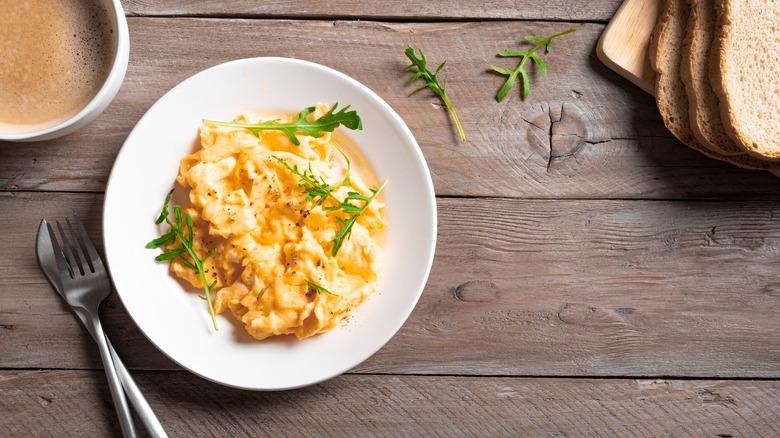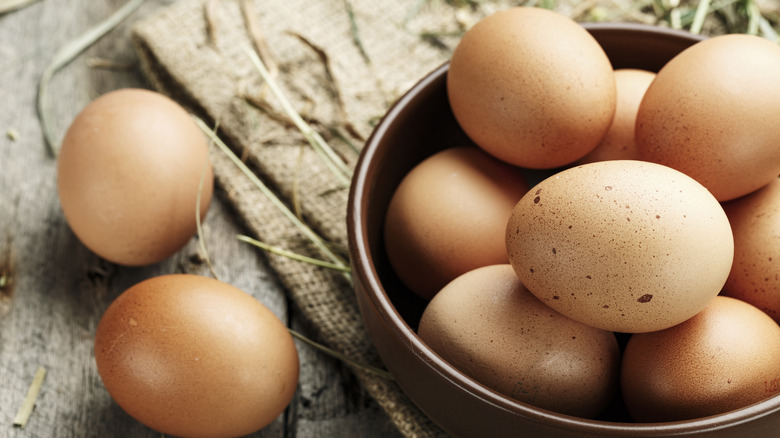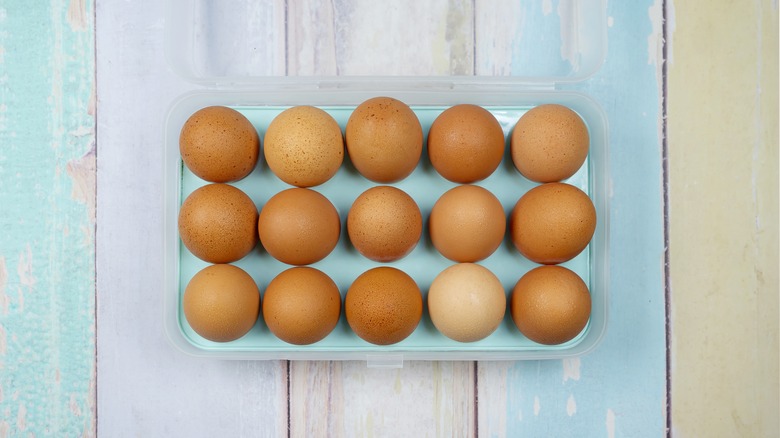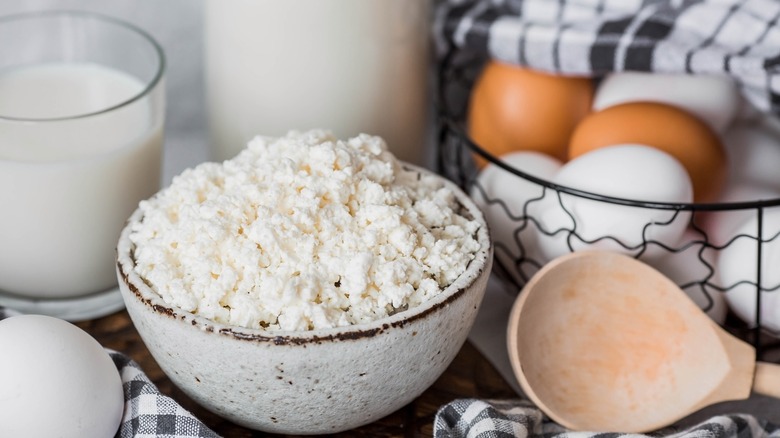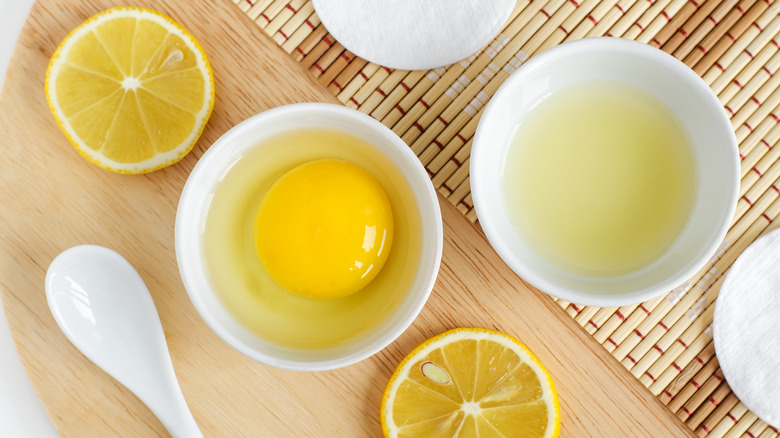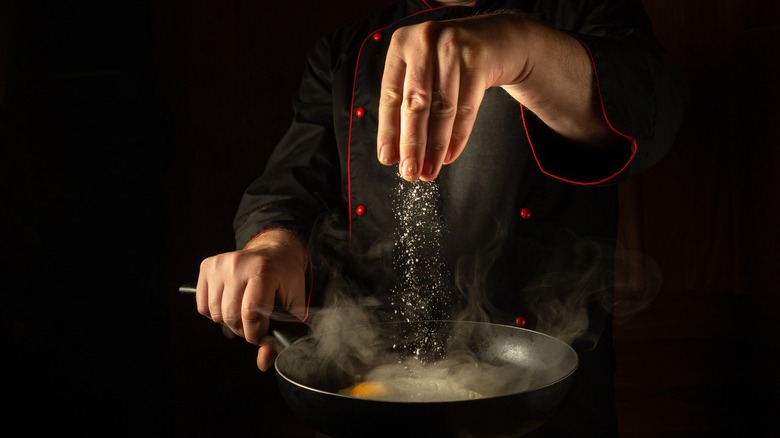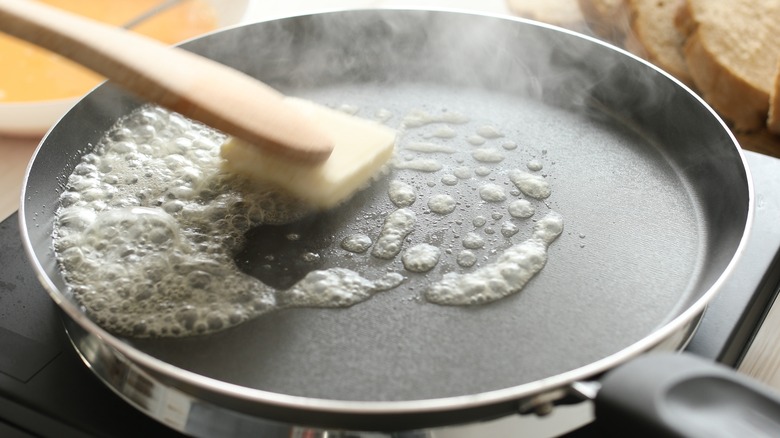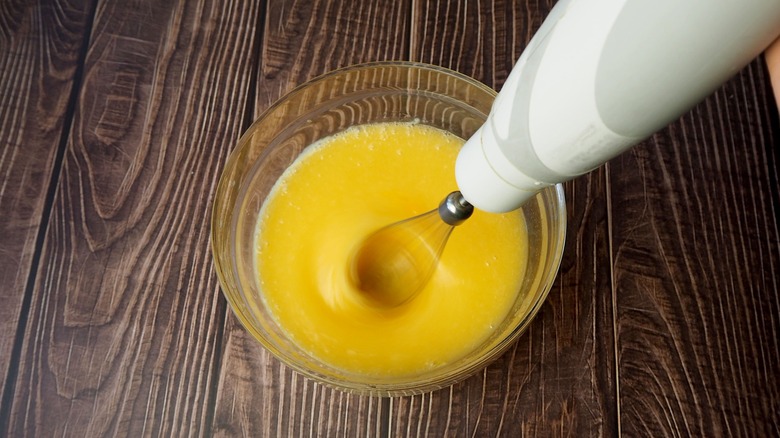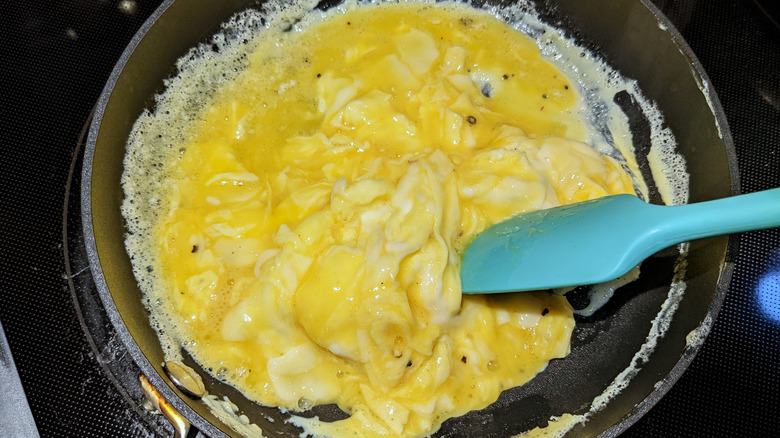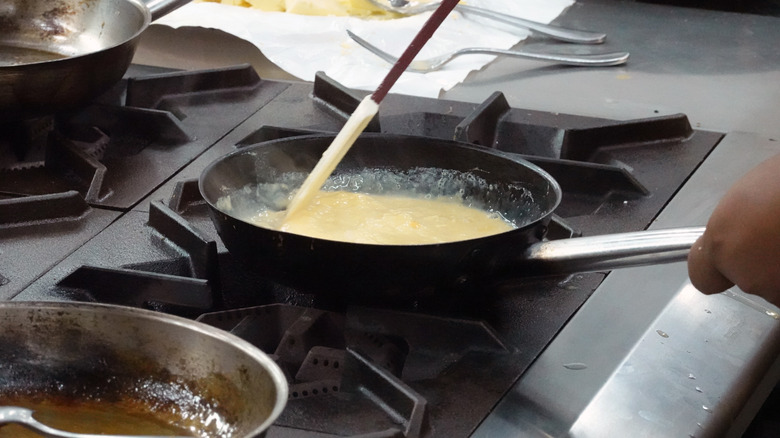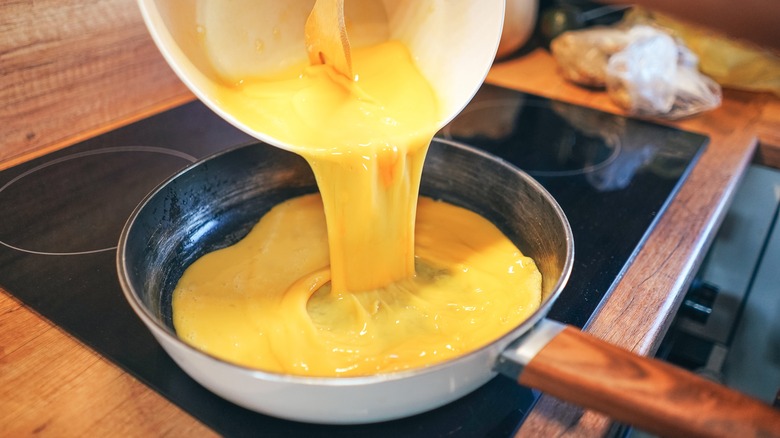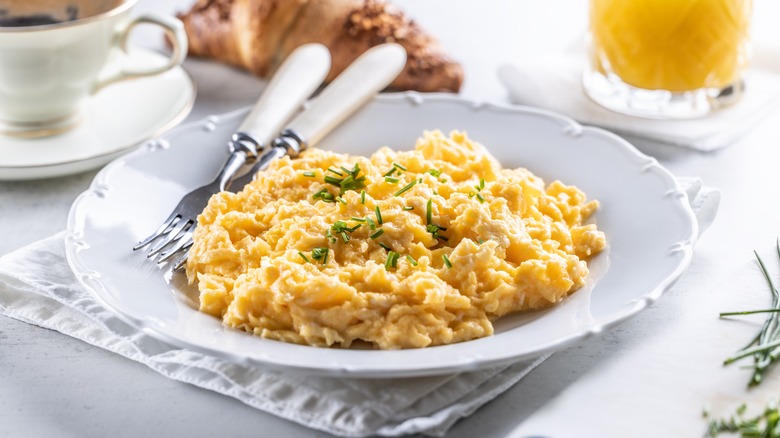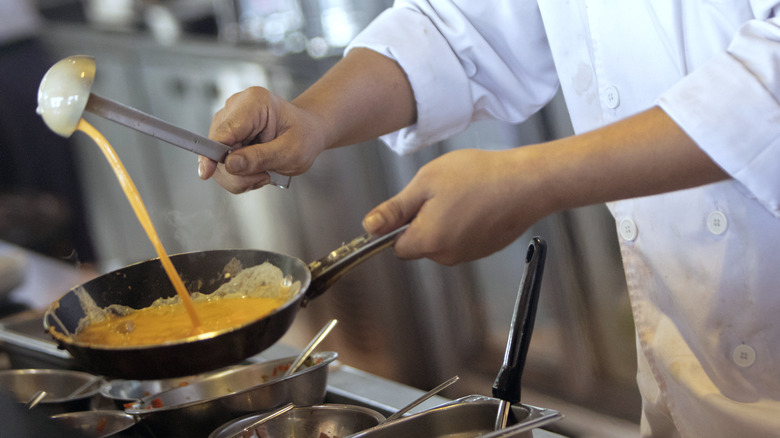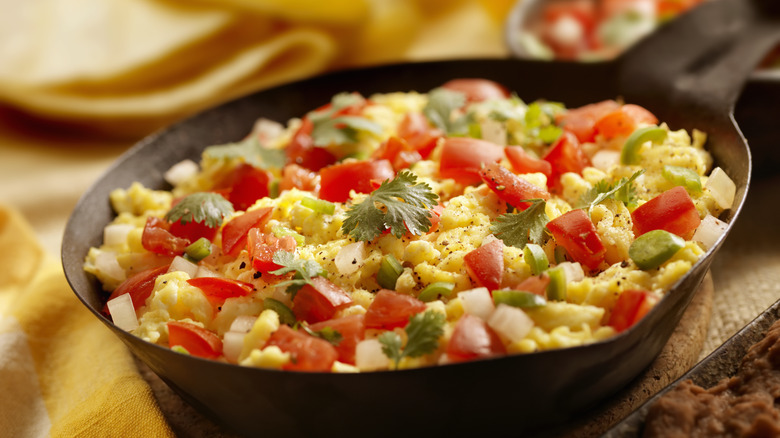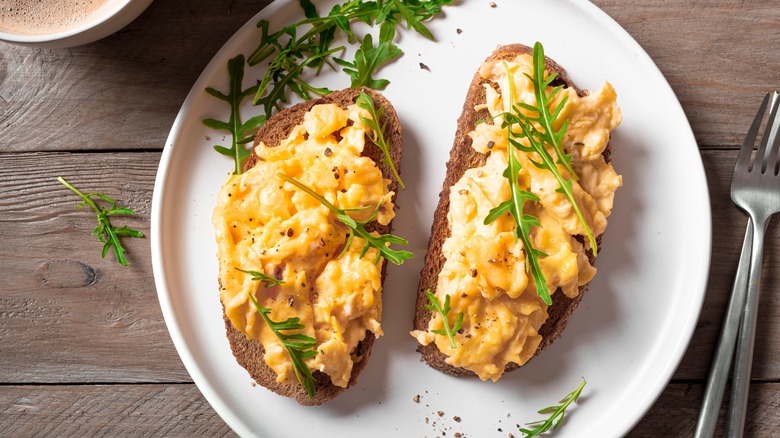Why Scrambled Eggs Always Taste Better At A Restaurant Vs At Home
As a chef, few ingredients inspire me more in the kitchen than the versatile egg. From breakfast to lunch to dinner, eggs are one of the bonafide rockstars of the kitchen. They are true chameleons capable of binding ingredients, adding richness to sauces, and even forming the base of some of the most luxurious desserts around. But, at their most basic, they shine when prepared simply and delicately, in the form of a classic scramble. While scrambled eggs seem easy enough to make, the ones we make at home often lack something compared with those you might get at a restaurant.
It is no secret that chefs know a thing or two about elevating any ingredient to the next level. This is no less true when it comes to scrambling up eggs. From which eggs to use to how to mix them to what you can add into them, restaurants know every hack out there to produce the most velvety, savory, and delectable scrambles around. As a chef with nearly two decades of professional experience running a restaurant and bed and breakfast, I know a thing or 30 about scrambling eggs, and I'm here to help illuminate the many tips and tricks out there that can transform your next scramble into something worthy of the finest dining establishment.
They buy the freshest eggs
There's no doubt that one of the most important factors in producing the highest quality scramble is to use the freshest eggs available. Getting fresh eggs is less challenging than it used to be, with the existence of more farmer's markets and gourmet grocery stores. In fact, many people have taken to keeping chickens in their own backyards as a hobby, affording them fresh eggs anytime. That said, restaurants still have an advantage in that they can purchase in bulk and source directly from the farm, enabling them to obtain the cream of the crop when it comes to fresh eggs.
While obtaining fresh eggs is a must, how they are stored is equally as important, as they are highly perishable and susceptible to exposure to pathogens, namely salmonella. While eggs can be safe to consume well beyond the "best by" dates listed on their cartons, this is contingent on maintaining them at a consistent cool temperature in the refrigerator, storing them away from other potentially hazardous foods, and keeping them in their original containers. Restaurants have the capacity to safely store large quantities of food because they rely on commercial refrigeration units and a well-regulated system of rotating inventory that is known as FIFO (first in, first out), which guarantees that ingredients are used in a timely fashion.
Restaurant chefs use room temperature eggs
While maintaining eggs at a cool temperature is necessary for safe storage, if you are about to scramble them, they should be at room temperature. Chefs and restaurateurs know this and will remove the eggs from refrigeration approximately 30 minutes before they are whisked together and scrambled. Room temperature eggs cook more evenly, heat through more rapidly, and are also easier to beat together uniformly. If you want smooth scrambled eggs and not ones that have clumps in them, it is absolutely necessary that you bring them to room temperature before you attempt to stir them together.
If you are in a pinch and running out of time, you can always expedite this process by soaking cold eggs in warm water for up to 10 minutes. The key is not using water that is too hot, otherwise it can begin to cook the eggs. You want them to be warm enough that they are no longer cold to the touch.
They use water, cream, or crème fraîche in the eggs
The addition of some kind of liquid, typically milk or water, to scrambled eggs is not exactly a novel idea. It is one that has been hotly contested, with some swearing by milk and others by water. In a side-by-side comparison, I determined that if you are looking for the fluffiest possible eggs, you will want to add water to your scramble. This is a technique that restaurants know well and implement regularly, though they don't always stop with water.
Chefs will often lean on more bougie ingredients to amplify their scrambled eggs. One of my favorite additions is heavy cream, which lends a richness while helping the eggs rise as they set. I am also extremely fond of incorporating cottage cheese into them, which not only confers a luxurious, pillowy texture, but a more toothsome mouthfeel. A close facsimile to this would be ricotta cheese, an Italian-style dairy product that has the added benefit of a hint of sweetness, which can enhance the inherent umami elements of the eggs. Lastly, if you want to go the route of many celebrity chefs, a dollop of crème fraîche is certain to produce impossibly creamy scrambled eggs worthy of any five star restaurant.
They add a hint of acidity to the eggs
Another common restaurant and celebrity chef trick for adding fluffiness to scrambled eggs is the incorporation of an acidic ingredient. At its most basic, a squirt of fresh lemon juice will do the trick, helping to firm up the protein strands within the eggs, while releasing water, which produces steam that helps moisten and leaven the scramble. Sherry or apple cider vinegar can produce similar results, albeit with a somewhat more potent flavor.
For a more neutral-flavored acidic kick, chefs will often lean into their knowledge of baking to enhance their scrambled eggs, by sprinkling some baking powder into the mixture. This combination of an acid, baking soda, and a filler helps cakes and cookies become perfectly fluffy. Moisture will begin to activate the leavening properties of baking powder, while heat continues to encourage it, coaxing tiny bubbles of carbon dioxide in between the protein strands of the eggs, making them light as a cloud.
They are generous with using salt
Chefs are obsessed with seasoning dishes to perfection. When it comes to scrambled eggs, adequate seasoning, in this case in the form of salt, is a game changer on a molecular level. Salt does a couple of things when added to scrambled eggs. While it helps the protein strands in the egg whites adhere to one another more rapidly and at lower temperatures, it does so in a gentle way that doesn't completely squeeze out any excess moisture between them. This yields lighter, fluffier scrambled eggs, as long as they are cooked delicately.
Though kosher salt is typically the go-to for cooking and baking, there is no reason why you couldn't amplify the flavor of eggs by using a fancy finishing salt, for example a Himalayan pink salt, fleur du sel, or a seasoned salt, like a smoked sea salt or truffle salt. Each of these has the capacity to transform the texture and flavor of your scrambled eggs in a way that will titillate your taste buds.
They don't shy away from fat
When you cook scrambled eggs, you always need to start with fat to help prevent them from adhering to the pan. Where home cooks may limit their intake of fat, restaurants understand that it not only equals flavor, it can enhance the texture of many dishes, especially something as simple as scrambled eggs. Oil can prevent scrambled eggs from sticking to the pan, but it can lack the boost of flavor that you can get from butter or other animal fats.
Butter in particular is ideal because it not only confers a luscious flavor, its inherent moisture content can help keep your scrambled eggs light and fluffy as the liquid evaporates and forms steam. For an even more sophisticated and restaurant-worthy variation, try using clarified or browned butter. These give the eggs a delightful color and a remarkable nutty flavor that is incomparable.
Lastly, we all know that bacon and eggs are marvelous bedfellows, but did you know that you can use rendered bacon fat to scramble up your eggs? It is always a good idea to strain any solid components out of the bacon fat before adding it back into the pan to cook up your eggs, so it will infuse them with flavor without changing their color markedly.
They blend them well
While some schools of thought recommend cracking eggs straight into a pan and then scrambling them, many chefs disagree. We like to prepare our egg mixture before adding it into a pan, by using a blender or immersion blender to purée the egg whites together with the yolks. Doing so helps to fully homogenize the ingredients while aerating them, which helps to give them an extra lift when they are cooked. But be careful not to overdo this — the eggs can quickly turn from light and fluffy to a clumpy mess; a few seconds is all you need.
Another step that can help produce a perfectly smooth, uniform egg mixture is straining the blended mixture through a fine mesh sieve. If there happens to be any leftover clumps of egg white or yolk in the mix, these will be separated from the final scramble, yielding more perfect curds that are smooth and creamy. Restaurants will often prepare a large batch of eggs in advance and store them in a container, a process known as pooling the eggs, which helps to expedite the cooking process.
They use the right type of pan and utensils
While many home cooks have a one-size-fits-all approach to cookware, restaurant chefs are very adept at utilizing the appropriate pan for the job at hand. When it comes to scrambling eggs, the key is using a pan that will help eliminate the potential for sticking. This is often achieved by using a high quality non-stick pan. There are many different options made from materials ranging from ceramic to cast iron to stainless steel. These pans should be roughly 10 inches in diameter and have sloped edges that ensure the eggs stay within the confines of the pan and don't splatter all over your stovetop.
While you may not think the type of utensil you use to stir your scrambled eggs makes a huge difference, some harsher than others for the job. Metal spatulas can scrape the bottoms of delicate non-stick pans, removing their protective coating, while wooden spoons are notorious for harboring bacteria. The ideal tool for scrambling eggs is a heat-safe silicone spatula or chopsticks. These are both gentle enough for the job and will not adversely impact the final dish.
They cook them over a lower temperatures
There has long been a debate as to whether you should cook scrambled eggs in a hot or cold pan. For some, using a pan that is just warm enough to melt the butter is ideal because it enables the eggs to cook more quickly and evenly. That said, it can be easy to go from done to burnt in one fell swoop. If you want to produce scrambled eggs à la any well-known French chef, consider a low-and-slow approach.
The low-and-slow cooking method adopted by French chefs leads to eggs that may not be as overtly fluffy, but still incredibly creamy and with a luxurious texture, consisting of small, even curds, rather than larger firm ones. The key is consistent stirring to guarantee that the eggs cook evenly and maintain a homogenous texture. Once they are almost finished, they are removed from the heat and a hint of residual egg mixture, cream, sour cream, or crème fraîche are stirred in, halting the cooking process and allowing for the scramble to retain its velvety texture.
They don't over or under stir the eggs
When cooking scrambled eggs, there is a fine line between over or under stirring them for the fluffiest, creamiest texture. While some chefs use a higher temperature, yielding firmer eggs that cook faster and require less stirring, others cook at lower temperatures and simply keep the eggs moving around so that they cook evenly. This is a delicate dance that an experienced chef has down to a science and has developed instincts for, gauging the appropriate amount of stirring based on the appearance of the eggs and how they give when pushed up against a spatula and the pan.
A good approach is to pour the egg mixture and butter into the cold pan and allow it to begin to heat through for a few seconds. As the pan warms and the eggs begin to heat, slowly begin folding the slightly cooked eggs from the edges of the pan into the more liquefied ones toward the center of the pan, allowing these to combine and develop smaller, delicate curds.
They don't overcook them
Overcooking scrambled eggs is another danger, particularly with ones cooked over a higher temperature. It is less likely, though still possible, when employing the low-and-slow approach of French chefs. As the legendary Julia Child always insisted, you are better off undercooking your scrambled eggs somewhat and allowing for any carryover cooking to occur off the heat, which will finish the eggs without firming them up too much.
One telltale sign of overcooked scrambled eggs is if they appear to be weepy after they are taken off the heat. Excess moisture from the eggs will be squeezed out of them as they continue to cook. This is a by-product of the way in which protein strands begin to firm up as they cook. Initially, these protein strands will retain the moisture within them, but after a certain point, they will no longer be capable of holding onto that liquid, resulting in a soupy discharge that makes your scrambled eggs dry and lacking in that lusciousness that makes the perfect scramble.
They cook them in batches
Another pitfall that is common when making scrambled eggs for a crowd, is trying to cook too many at once, resulting in an overcrowded pan. While it may seem tempting to cook a huge batch of eggs at the same time, this can result in uneven cooking, with some ending up overdone while the others are underdone. Restaurants compensate for this by cooking eggs to order in smaller batches. If you are using a typical 10-inch skillet, add no more than six eggs at a time to the pan for best results. As a good rule of thumb, a hearty serving-size of scrambled eggs is around three eggs per person, so a batch of six eggs can feed two people.
Restaurants have the added luxury of owning industrial-sized cookware, which means they can, and often will, cook more eggs at one time. This is something best left for experts to do, as chefs will have developed the proper techniques to accommodate for a larger batch that will guarantee the eggs remain light and fluffy, and don't get overcooked, hard, and dry.
They aren't afraid to doctoring them up
While plain scrambled eggs can be delightful, they can almost always benefit from a creative mix-in or two to help doctor them up and give them a more complex flavor profile. When it comes to layering flavors and knowing what pairs well with what, restaurant chefs have a leg up on home cooks by virtue of their education and experience. They understand the nuance of how different ingredients can play off of one another.
Celebrity chef-approved ingredients to jazz up scrambled eggs are multifold, including items like orange zest, freshly shaved truffles, and soy sauce. Some, like legendary Spanish chef Ferran Adria, even swear by adding quirky ingredients, like crumbled potato chips, to scrambled eggs, to boost flavor and texture. Other exemplary add-ins can include items like fresh herbs, smoked salmon, sautéed vegetables, or freshly grated parmesan cheese. They sky's the limit when it comes to jazzing up scrambled eggs. The key is to use these add-ins to accentuate the eggs themselves, not mask their inherent flavor. Ultimately, the eggs should still be the star of the show, so moderation is recommended.
They plate them carefully
If you want to capture the panache of a fine dining experience, you will want to think like a chef and pay extra attention to what goes on your plate of scrambled eggs. People eat with their eyes and noses first, so you should always consider color and aroma when contemplating suitable garnishes. A sprinkle of verdant herbs or a dash of freshly grated cheese can brighten up scrambled eggs, but don't stop there. There are plenty of different ingredients that can provide playful color, aroma, and textural interest to scrambled eggs.
Additionally, restaurants are well-known for either chilling or heating their plates accordingly to match the dish they are serving. This is crucial to elevating the dining experience, especially where scrambled eggs are concerned. You don't want the eggs getting cold quickly when they hit a chilled or room temperature plate. This can cause them to become rubbery and chewy, losing all of that creaminess and fluffiness you so painstakingly worked to achieve. The key is to not overdo it. The plate shouldn't be so hot that it continues to cook the eggs, but just hot enough to keep them warm.
